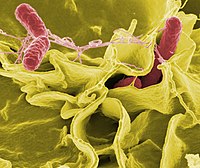
Photo from wikipedia
Poultry and poultry-derived products such as meat and eggs are among the main sources of non-typhoidal Salmonella (NTS) transmission to the human. Therefore, we performed a systematic review and used… Click to show full abstract
Poultry and poultry-derived products such as meat and eggs are among the main sources of non-typhoidal Salmonella (NTS) transmission to the human. Therefore, we performed a systematic review and used random-effects meta-analyses to 1) estimate the prevalence of NTS in poultry samples from birds, products and subproducts and environmental samples, 2) examine the diversity and frequency of their serovars and 3) estimate the prevalence and profiles of antimicrobial resistance (AMR) in NTS isolates reported in studies from the Americas. We included 157 studies from 15 countries comprising 261,408 poultry samples and estimated an overall pooled prevalence of 17.9% (95% CI: 10.8-26.3) in birds, 21.8% (17.7-26.1) in products and subproducts and 29.5% (24.2-35.1) in environmental samples. At the national level, the prevalence of NTS was heterogenous across countries with the highest values in Mexico, the USA and Canada. In total, 131 serovars were identified from 13,388 isolates, Heidelberg, Kentucky, Enteritidis and Typhimurium were the most prevalent in the overall top 10 ranking (range 6.5-20.8%). At the national level, Enteritidis and Typhimurium were identified in most of the countries, though with national differences in their ranks. The prevalence of AMR increased from 24.1% for 1 antibiotic, to 36.2% for 2-3 antibiotics and 49.6% for ≥ 4 antibiotics. Kentucky, Heidelberg, Typhimurium and Enteritidis were the serovars with the highest prevalence of AMR. Besides, tetracycline, ampicillin, streptomycin, ceftiofur and amoxicillin-clavulanic acid were the most frequent antibiotics to which NTS showed resistance. In conclusion, NTS was distributed through the avian production chain with high and heterogenous values of prevalence in poultry samples. Besides, there were distinctive patterns of serovars distribution across countries and an alarming prevalence of AMR among zoonotic serovars. This article is protected by copyright. All rights reserved.
Journal Title: Transboundary and emerging diseases
Year Published: 2021
Link to full text (if available)
Share on Social Media: Sign Up to like & get
recommendations!